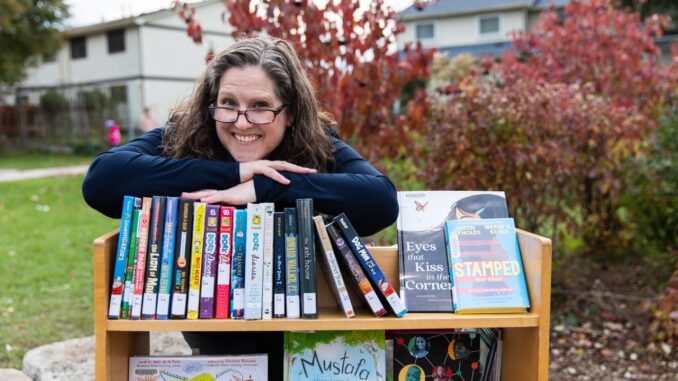
Only 52 per cent of elementary schools had a school librarian in 2017. With the province’s new funding announcement, that number is expected to fall even lower
By Kunal Chaudhary
This story was originally published by TVO Today on September 4, 2024. It is reproduced here with permission.
For the first time in 27 years, Johanna Gibson-Lawler will not be working as a school librarian.
Instead, the veteran teacher-librarian in the Greater Essex County District School Board will be returning to the school she helped open 17 years ago, but as an elementary science and social-studies teacher.
“I’m devastated,” she says. “Not only for myself, but for all the kids.”
Lawler is one of hundreds of teacher-librarians and library technicians whose jobs have been compromised by the Ministry of Education’s recent overhaul of school funding. Under the Core Education Funding model, money that had previously been required to be spent on school libraries and library staff has now been pooled into a broader Learning Resources Fund — which includes funding for guidance counsellors and mental-health workers, as well as learning materials such as crayons and erasers.

in the Greater Essex County District
School Board.
(Courtesy of Johanna Gibson-Lawler)
The Core Education Funding model also eliminates accountability measures that had been imposed by the ministry on school boards to ensure that enveloped funding such as that for school libraries is spent in the right places. Announced just three years ago, these accountability measures revealed that a third of Ontario school boards were spending less than the provincial funding allocated for school libraries and staff.
“I just thought the wheels were really turning, and we were making some great progress,” says Lawler, who is also the former president of the Ontario School Library Association. “And now, with this funding-formula change, we’re going to have such inequity across the province. It’s absolutely heartbreaking.”
By the Numbers
While this new funding announcement will accelerate the loss of access to school libraries for Ontario students, the decline is nothing new.
The education-advocacy and -oversight group People for Education found that, in 2017, only 52 per cent of elementary schools had a teacher-librarian, down from 80 per cent in 1998. Of these, only 11 per cent were full-time teacher librarians.
This reduction in library staff has hit some parts of the province harder than others. That same report found that, in northern Ontario, only 11 per cent of elementary schools employed a teacher-librarian.
“We know there are some boards that have no teacher-librarians that we know of, and a couple of boards in the province have no school libraries at all,” says Wendy Burch-Jones, president of the Ontario School Library Association.
This loss of access prompted the province to impose accountability measures for school boards in 2021 that required boards to report how they were spending the money allocated for school libraries and library staff. The Ministry of Education funds one teacher-librarian for every 763 elementary students and one for every 909 secondary students.
Before these accountability measures were enacted, the Ontario Library Association estimated that up to half of these funds — as much as $100 million annually — were being allocated elsewhere.
“Technically, that money is still there,” says Burch-Jones. “But now, boards who already face really difficult decisions with a lot of competing interests have been given more flexibility to make decisions on how they spend those budgets. Our fear is that more libraries and library staff are going to be on the chopping block.”
In a statement to TVO Today, a spokesperson for the Minister of Education wrote that “the Core Education Funding model continues to provide the same level of funding for school libraries including for teacher librarians with no funding reductions to school libraries. Through this process, funding was realigned but not reduced in any way.”
The past two decades have also seen a steady loss of interest in reading from Ontario students. In 2018, just under 45 per cent of students in Grades 3 and 6 reported that they liked to read; more than a third of them said they are “not good readers most of the time.”
A report by the Ontario Human Rights Commission concluded these figures suggest that “current approaches to reading are failing to teach many students to read, and to promote reading confidence and a love of reading in many more.”
Burch-Jones, who also administers the Forest of Reading program for middle-school students — the largest school-based reading program in Canada — says school libraries are key to getting students to re-engage with reading.
“The reality is that the school library is the one place in the school where students have access to find what really interests them,” she says. “That’s where they have the ability to build the one critical skill that is the foundation for all other subjects. We talk all the time about kids needing to develop a love of reading, but the reality is that if they are not good at reading, then they’re going to struggle to be successful anywhere. And they’re not going to be interested in reading unless they have something they want to read.”
Boards doing “much more with much less”
“It’s a very real possibility that, in the near future, schools will not have a school library unless we make real changes and unless we become aware of the situation and the opportunities to make change right now,” says Michelle Arbuckle, executive director of the Ontario Library Association.
In the short-term, Arbuckle and the OLA are asking for the province to do the following to protect school libraries:

director of the Ontario Library Association.
(Courtesy of Michelle Arbuckle)
“First, we’d like the minister of education to identify school libraries and library staff as an investment that school boards are expected to make,” she says. “Second, to fully protect that allocation so that every board is expected to invest all of that money as per that allocation. And third, to restore accountability measures.” Until then, teacher-librarians such as Johanna Gibson-Lawler will continue to be reassigned or laid off, and Ontario students will continue to bear the brunt of the downstream effects of losing their school library.
It is an impact that, she says, will be especially pronounced as students increasingly turn to the internet.
“In this age of misinformation, the teacher-librarian is the one that is going to teach kids that not everything they read on the internet is real, how to validate sources, how to differentiate between truthful and fake news, how to be good digital citizens,” she says. “This makes the role of the teacher-librarian especially critical.”
She also cautions against placing the blame for this loss of access entirely on school boards.
“It’s not the boards — they’re really trying to do much more with much less,” she says. “As much as this government is touting that they’ve increased the funding, it’s not keeping up with inflation. We need dedicated funding to help drive where education is going in a consistent manner.”
She recalls one conversation with a superintendent from another school board about this situation.
“She said, very clearly, the minister has set us all up to fail. That’s really what it comes down to,” Gibson-Lawler says. “So I don’t blame our board or any boards. It’s the ministry that has completely let Ontarians down with how this funding is shaking out.

Kunal Chaudhary is a journalist and editor based in Toronto.
@KunalChaudhary_